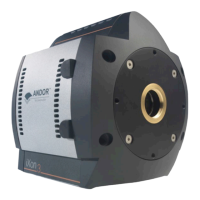Page 73
Appendix
A1.1.13 - Quantum Efciency/Spectral Response
Theglossaryreferstosignalsasanumberofelectrons.Morestrictlyspeakingtheseare“photoelectrons”,created
when a photon is absorbed. When a UV or visible photon is absorbed by the detector it can at best produce only
one photoelectron. Photons of different wavelengths have different probabilities of producing a photoelectron and this
probability is usually expressed as Quantum Efciency (QE) or Spectral Response.
QE is a percentage measure of the probability of a single photon producing a photoelectron, while spectral response
is the number of electrons that will be produced per unit photon energy. Many factors contribute to the QE of a CCD,
but the most signicant factor is the absorption coefcient of the silicon that serves as the bulk material of the device.
A1.1.14 - Readout
Readout is the process by which data are taken from the pixels of the CCD and stored in computer memory. The pixels,
which are arranged in a single row, are read out individually in sequence. Readout involves amplifying the charge on
each pixel into a voltage, performing an analog to digital conversion then storing the data in computer memory. The time
takentoperformthisoperationisknownasthe“readtime”.
A1.1.15 - Saturation
Saturation is the largest signal the CCD can measure. A signal is measured in terms of the amount of charge that has
built up in the individual pixels on the CCD-chip. A number of factors determine the maximum amount
of charge that the CCD can handle
A1.1.16 - Scans (Keep Clean & Acquired)
TheCCDiscontinuallybeing“scanned”topreventitsbecomingsaturatedwithdarkcurrent(seeDark Signal on page 80).
• IftheScanisbeingusedsimplyto“clean”theCCD(i.e.itisakeep-cleanscan),thechargefromtheCCDis
discarded.
• Inanacquiredscanhowever,thechargeundergoesanalogtodigitalconversionandisacquired
intocomputermemorysothatitcanbeusedforsubsequentprocessinganddisplay:itis“readout”(see
Readout above).
Unlessthecontextspecicallyindicatesotherwise,“scan”inthisUserGuidegenerallyreferstoanacquired
scan.
A1.1.17 - Shift Register
The Shift Register usually consists of a single row of elements (or pixels) running parallel to and below the
bottom row of light-gathering pixels (the image area) on the CCD-chip. The shift register is protected from light by an
aluminiummask.Theelementsintheshiftregisterhaveagreatercapacitytostorecharge(i.e.agreater“welldepth”)
than the other pixels on the CCD-chip

